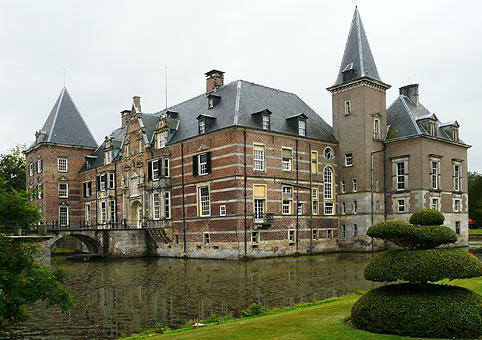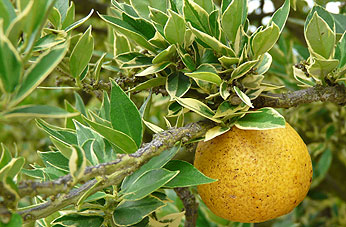
see also:
...at Twickel Castle Estate, near Delden, Netherlands
Twickel holds the smaller part of the National Citrus Collection, but the moated castle, the beautiful park and garden - less formal than the one at Het Loo Palace - make for a memorable visit.




The orangery dates, in its current form, from the first half of the 19th century. In summer it is used as a tea-room, with the potted plants moved into the garden.
The moated castle is only open to the public by special arrangement.
There are historical links between Twickel and certain English gardens.










Many of the citrus trees at Twickel appear to be varieties of Citrus aurantium, the bitter orange. There is a nice example of Corniculata fruit shown below. Unlike at Het Loo palace, most trees are not labelled.
There are two magnificent specimens of Citrus aurantium Myrtifolia,the Myrtle-leafed Bitter Orange or Chinotto, one of them being the rarely-seen variegated form.
There are two magnificent specimens of Citrus aurantium Myrtifolia,the Myrtle-leafed Bitter Orange or Chinotto, one of them being the rarely-seen variegated form.
click this image for high def version
click this image for high def version
Some of the citrus trees at Twickel are leaning over at a severe angle, sometimes supported by wires. Some trees also show symptoms of severe foot rot, yet still seem to be thriving. Although the pots are identical to those at Het Loo, in some cases the Twickel trees are growing much lower down within the container. Ben Groen, curator of Het Loo gardens suggested this can happen when fertilisation is by removing and replacing the top few centimetres of soil. Over many years the plant sinks lower.
In the garden at the back of the orangery, I came across several old potted speciments of Poncirus trifoliata, the hardy Japanese Bitter Orange. I would like to find out the history of these plants, and how old they actually are, because I believe this species was a fairly late introduction into Europe.
Moestuin Twickel
is the old walled kitchen garden of the Twickel Estate. Staffed by volunteers, it is open to the public on certain days of the week. It also now contains a commercial garden centre. In one area I found a number of small citrus plants propagated from the Dutch National Collection. I don't think these were meant to be sold - more likely being kept as reserve plants for Twickel and Het Loo.
Useful web links about Twickel and Dutch citrus:


Aerial View from GoogleMaps
GoogleMaps has an impressive aerial view of the Twickel Estate. Click on the picture above for a full-screen image. The orangery is the curved building near the centre of this picture. Are the lakes partly frozen? It looks like it - yet all the trees are in leaf, so it can't be winter!
Bitter Oranges in the Netherlands
Eight-page PDF book extract in Dutch
Eight-page PDF book extract in Dutch
Article by Henk Saaltink
(46Kb MSword download)
(46Kb MSword download)
Article by Hans Hondebrink & Henk Saaltink
(47Kb MSword download)
(47Kb MSword download)
page updated 25th November 2010 , 3rd April 2020



